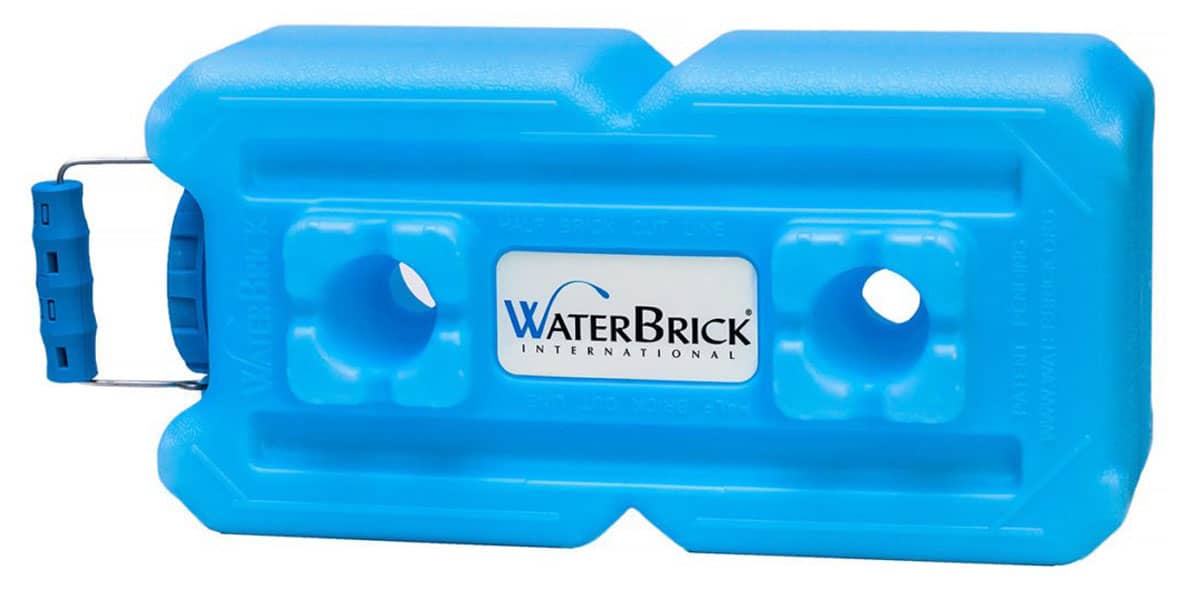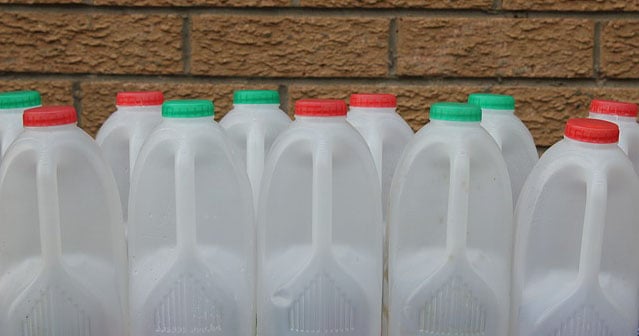The Best Containers for Long-Term Water Storage?


[ad_1]
When I started with disaster preparedness, I kept my emergency water in empty milk jugs and other plastic bottles. Since then, I’ve upgraded to water storage containers – including WaterBrick.
Here’s my opinion of WaterBrick and whether I think they are worth the cost.
Why Invest in Water Storage Containers?


A lot of people don’t know that standard plastic bottles are degradable. It takes some time (about 6 months to 1 year), but those plastic bottles will slowly develop pin-size holes. Keep water in them long enough, and they will start to leak.
This is one of the biggest mistakes I made when I started stockpiling water.
One day, I walked into my pantry and found the floor covered in water!
Another issue is that standard plastic bottles will leach chemicals into your water. In the aftermath of a disaster, I doubt you will care that some plastic chemicals are in your water. Read more about it here: Does bottled water go bad?
But, if you can avoid it, why not?
Solutions:
- Rotate your water: Every 6-12 months, you need to get rid of all the water you’ve stockpiled and get completely new plastic bottles. This is a significant pain in the butt!
- Invest in water containers: Water containers (such as those marketed for boats and RVs) are made from non-degradable material. You can keep water in these for a long time, saving you the annoying hassle of rotating water.
WaterBrick Review
The bricks are available from Amazon. Links are included below for your convenience.
There are a lot of different water storage containers available. I’m going to break down how WaterBrick compares to the competitors based on the most important factors:
Size
The standard WaterBrick is 9 inches wide, 18 inches long, and 6 inches high. It holds 3.5 gallons of water.
This is smaller than most of the other water containers you’ll see for sale (most of which are 5+ gallons). Yes, this means that each WaterBrick holds less water.
However, it also means that the full containers are much easier to carry.
3.5 gallons of water = approximately 29lbs. I’m a small-framed woman and find it easy to carry the WaterBricks. A water container that is 5 gallons is already 41lbs. As strong as I am, that is pretty tough to carry!
*WaterBrick also has a smaller-sized option. It is 1.6 gallons. I find this one too small for emergency water storage. It is great for keeping in your car or taking with you on picnics, though.
Leakage
Speaking from experience, it is incredibly frustrating when your water containers spring a leak. Luckily, this has never happened to me in a disaster situation or even while out camping.
But I have had many cheap water containers crack because of jostling in my truck.
The WaterBrick is true to its reputation that it won’t leak.
Use caution when twisting the lid to be sure the gasket is positioned correctly. Otherwise, you won’t get an air-tight seal, which could leak.
Ease of Use
If you get WaterBricks, make sure you get the spigot too. Even though they aren’t very heavy, the mouth on them is huge. This makes it very difficult to pour water into a standard bottle without spilling. The spigot solves that problem.
The spigot comes as a separate lid. Just screw the spigot lid in place of the standard lid.
Ventless Design
One cool thing about the spigot is that it is “ventless.” If you haven’t dealt with water jugs before, then you might not know that they usually need to have an air hole on the opposite side of the spigot. Otherwise, a vacuum forms as the water comes out of the spigot.
The WaterBrick spigot design means that a vacuum won’t form, so you don’t have to vent the containers. This helps make them more sturdy and prevents contamination of the water.
Durability
When it comes to durability, WaterBrick is probably the best container out there. They’ve been drop-tested, crush-tested, frozen…. Nothing seems to destroy these containers.
Some notes about the durability of WaterBricks:
- A 5-year guarantee backs all WaterBricks
- Are safe in temperatures from -104 to 230 degrees F
- Can be frozen – but you must leave some room to account for water expansion
Check out this parachute drop test!
Material
Up until recently, pretty much all water containers were made from some sort of BPA plastic. Lots still are. However, as the public has been made aware of the dangers of BPA, you can now see lots of water containers advertising themselves as “BPA free.”
But, just because something is “BPA free,” it does NOT mean it is safe!
There are plenty of other chemicals in plastic which can leach into your water or food. According to this source, studies have found that all plastics (even those without BPA) leach chemicals that can affect our hormones.
WaterBricks are made out of High-Density Polyethylene resin (HDPE), and the lids are made of High-Density Polypropylene. The gasket is made from Dynaflex TPE.
Are these 100% safe? Probably not – but they are certainly better than the thin, crappy plastics that cheap water containers are made out of.
Unfortunately, there’s not much we can do about avoiding the chemicals in plastic. You could store your water in glass containers, but this is impractical. A natural disaster would cause your entire water stockpile to shatter into pieces.
I’ll risk a bit of plastic residue.
Storage
This feature makes WaterBrick different from virtually every other water container out there. Each of the bricks has two holes in it. These holes add strength to the bricks and make it possible to interlock with other bricks.
You can stack up the WaterBricks like Legos.
The bricks can safely be stacked up to 4 feet high without tipping over.
I’ve heard reports that they could be stacked up to 7 feet high, but I assume you’d have to have a broader stack to add stability.
Transportation
Another cool feature of WaterBricks is that they have a handle that folds in/out of a cutout. This means you can stack them without having to remove the handle.
The handle is sturdy and feels good in the hand. There are even grooves for your fingers. It seems to be attached to the container well, so I’m not worried about it tearing out of the plastic. If you lose a handle, you can order replacements.
I also like that WaterBricks are rectangular and not round. They won’t roll around in the bed of a truck. The shape also means they have a lower center of gravity, so they are less likely to topple over than jerry-can styles of water containers.
Versatility
Because WaterBricks are made from food-safe plastic and have air-tight seals, you can also use them for storing your emergency foods. The 3-inch mouth means you can reach your entire hand inside to get supplies.
I wouldn’t use WaterBricks to store foods like flour or sugar. Those foods would get stuck to the sides of the containers. But, for items like grains and beans, they should be perfect. Just remember to follow proper long-term food storage procedures before filling them.
The WaterBricks website also has some excellent suggestions about other ways to use their containers:
- For building a wall or hunting blind
- As a Trombe wall for heating your home
- To make ice blocks for keeping food cold during power failures
- Brewing beer or wine
- Radiation barrier
Price
Here is the part that sucks about WaterBricks. Compared to other water storage containers, they are pricey.
You can save a lot of money by purchasing WaterBricks in bulk, but the cost is still high compared to other options.
Except that the other options aren’t stackable.
There is this 5-gallon option which is a bit cheaper per gallon. However, they don’t stack nearly as well, aren’t as tough, and are hard to pour (no spigot is available).
Another option would be to get standard 5-gallon water jugs but buy a storage shelf like this one. But remember that those jugs degrade, so you’ll have to get new jugs every couple of years.
There’s also a version called AquaBrick, which is stackable. I haven’t tested these myself. But, since the price is the same as WaterBrick, I’ll stick with WaterBricks.
Pros/Cons of WaterBricks
Tips for Using
Even in a container like WaterBricks, you should rotate your emergency water every 1 year or so. However, if you sterilize the WaterBricks before filling with water and add some water preserver, you can go 5+ years without having to rotate.
The Bottom Line?
I love the design and durability of WaterBricks. I just wish they didn’t cost so much! However, the investment does pay off when you consider that most cheap water containers will spring leaks within a few years.
If you want to build up a basic stockpile of emergency water and don’t want to worry about rotating, I’d buy WaterBricks.
Just make sure you get the spigot to make your life easier!
If you are serious about stockpiling large amounts of water, WaterBricks aren’t a reasonable solution. Instead, I’d recommend diversifying your water storage containers.
Get some large water storage barrels for complete SHTF situations. And have about 6 to 12 WaterBricks handy for shorter-term emergencies.
What do you think? Are they worth it? Let us know in the comments!
[ad_2]
Source link
Recent Posts
Dear Diary, It’s Me, Jessica: Part 16
[ad_1] If you're new here, you may want to subscribe to my RSS feed. Thanks…
Google Faces Lawsuit After $5M in Crypto Stolen via Play Store App
[ad_1] A Florida woman, Maria Vaca, has sued Google in a California state court, alleging…
All About Water Purification: A Complete Tutorial
[ad_1] You may need to purify water to make it safe to drink. The process…
Protocol Village: Quai Releases Mainnet-Compatible Devnet, Crunch Lab Raises $3.5M
[ad_1] The latest in blockchain tech upgrades, funding announcements and deals. For the period of…
The Grim New Daily Life in Venezuela
[ad_1] If you're new here, you may want to subscribe to my RSS feed. Thanks…
World’s 3rd largest public pension fund buys $34M MicroStrategy shares
[ad_1] The third-largest public pension fund in the world has just bought nearly $34 million…
